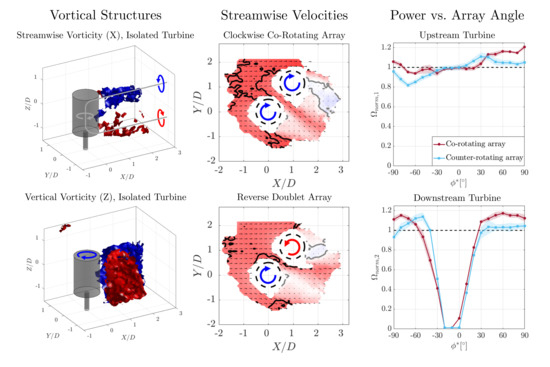Etats-Unis – Jeudi 18/07/2019 – energiesdelamer.eu. Cette étude Aerodynamically Interacting Vertical-Axis Wind Turbines: Performance Enhancement and Three-Dimensional Flow publiée le 16 juillet dans Energies 2019 a examiné les champs de vitesse moyenne volumétrique tridimensionnels et les mesures de performance correspondantes pour une éolienne à axe vertical isolée (VAWT) ainsi que pour des paires de VAWT à co-rotation et contre-rotation avec des directions de vent et espacements des éoliennes variables.
Abstract
Authors : Ian D. Brownstein 1, Nathaniel J. Wei 1 and John O. Dabiri 2,*
1 – Mechanical Engineering, Stanford University, Stanford, CA 94305, USA
2 – Mechanical Engineering and Civil & Environmental Engineering, Stanford University, Stanford, CA 94305, USA
This study examined three-dimensional, volumetric mean velocity fields and corresponding performance measurements for an isolated vertical-axis wind turbine (VAWT) and for co- and counter-rotating pairs of VAWTs with varying incident wind direction and turbine spacings. The purpose was to identify turbine configurations and flow mechanisms that can improve the power densities of VAWT arrays in wind farms. All experiments were conducted at a Reynolds number of http://www.w3.org/1998/Math/MathML » display= »inline »>ReD=7.3×104″ role= »presentation » style= »box-sizing: border-box; max-height: none; display: inline; line-height: normal; word-spacing: normal; overflow-wrap: normal; white-space: nowrap; float: none; direction: ltr; max-width: none; min-width: 0px; min-height: 0px; border: 0px; padding: 0px; margin: 0px; position: relative; »>ReD=7.3×104. In the paired arrays, performance enhancement was observed for both the upstream and downstream turbines. Increases in downstream turbine performance correlate with bluff–body accelerations around the upstream turbine, which increase the incident freestream velocity on the downstream turbine in certain positions. Decreases in downstream turbine performance are determined by its position in the upstream turbine’s wake. Changes in upstream turbine performance are related to variations in the surrounding flow field due to the presence of the downstream rotor. For the most robust array configuration studied, an average 14% increase in array performance over approximately a 50° range of wind direction was observed. Additionally, three-dimensional vortex interactions behind pairs of VAWT were observed that can replenish momentum in the wake by advection rather than turbulent diffusion. These effects and their implications for wind-farm design are discussed.
Full text
Publicités Google :





